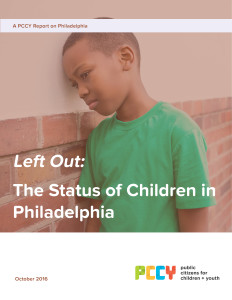Children Still in Recession in Philadelphia Despite Recovery
El aumento de la pobreza infantil y el menor rendimiento de los estudiantes ensombrecen los modestos logros
 Philadelphia (Oct 31, 2016) – While recent headlines tout a national recovery from the Great Recession, more children in Philadelphia are facing hardships than during the depths of the recession, a new study has found.
Philadelphia (Oct 31, 2016) – While recent headlines tout a national recovery from the Great Recession, more children in Philadelphia are facing hardships than during the depths of the recession, a new study has found.
Ciudadanos públicos para la infancia y la juventud [PCCY] anunció nuevas informes completos on the status of children in Philadelphia, Montgomery, Bucks, Chester and Delaware counties, entitled, “Left Out.” The Philadelphia report was released today.
“An American tragedy is happening right before our eyes, yet it’s very hard to see. The headline news touts a strong economic recovery, and monthly jobs reports amplify that message. But PCCY dug into the data and in Philadelphia found a very different and alarming story that does not bode well for children or the city,” said Donna Cooper, Executive Director of Public Citizens for Children and Youth.
The new PCCY “Left Out” series unveils a Child Wellness Index that measures if children are worse off or better with respect four domains: K-12 education, early childhood education, health and economic well-being. Compared to 2008 when the recession was just beginning, in two Child Wellness Index domains – economic well-being and K-12 education – children in Philadelphia are faring worse. For early childhood education their situation has not improved, while their health status has improved considerably.
“It’s pretty startling that in nine of the 14 Index measures, children were faring worse in Philadelphia compared to 2008. Even where children are doing better, thousands of children are up against very bad odds,” said Cooper.
El repunte económico aún no llega a los niños
“Philadelphia is on the rebound, so it is hard to believe that more children are growing up in poor families today than during the depths of the last recession. Most of these children are Black and brown, and living in historically under-resourced communities. We need to take decisive action now so that children, no matter what their race, ethnicity or zip code, have the resources they need to do well in school and in life.” – Mitchell Little, Executive Director, Mayor’s Office of Community Empowerment & Opportunity
- Five years after the recession (2015), Philadelphia’s child poverty rate continued to rise to 38.3%, or 130,800 children, far higher than the 31.5% at the start of the recession. That is nearly as many children as are enrolled in the entire School District of Philadelphia.
- Among the children in poverty, about half – 63,500 – are living in families earning less than half of the poverty level ($10,000 or less per year for a family of three). That’s enough children to fill every seat in the Phillies’ AND Flyers’ stadiums.
Schools Have Less Funds Even With More Students Who Need Extra Help
“Our schools succeed when children receive the supports they need both during the school day and at home. I’ve seen this as a teacher, as a school principal and as a parent. Philadelphia educators and community members do amazing things, sometimes under very difficult terms. Our schools require increased and sustained investments so we can provide all students with the learning opportunities they deserve.” – Marjorie Neff, Chair, School Reform Commission
- The elimination of Stimulus state and federal aid in 2011 meant that the School District of Philadelphia had $15,200 less to spend per classroom by 2014, despite numerous local tax increases.
- As a result, student performance declined. More than 43,800 public school students in grades 3-8 could not pass state reading assessments in 2014, a full 53% of students in the city. This fail rate is two points higher than in 2008 and eight points higher than in 2011. The pass rate for math declined even faster than reading, pushing the fail rate to 50% in 2014 – three points higher than in 2008 and a full 13 points higher than in 2011.
Mejoró el acceso a experiencias de aprendizaje temprano de calidad, pero la mayoría de los niños pobres aún no reciben este comienzo inteligente
“Early childhood education is so much more than babysitting. [At DCS] we help children develop all the foundational skills, from scientific thinking to regulating their emotions, that they will build on for the rest of their lives. But our families cannot be expected to pay for this, any more than we would expect every family to pay the cost of private schools from K-12. My great frustration as one of the highest quality providers in the city is that government does not fund the true cost of quality. Without that, we will never be able to bring this to scale, and that is what will transform our schools and our city. “ – Otis Bullock, Executive Director, Diversified Community Service
- Young families are struggling with the rising costs of child care in Philadelphia, where 70% of children under six years old have all parents in the workforce. Full-time childcare for two children (a preschooler and an infant) totaled $21,320, or more than half of the city’s median household income.
- Slightly more children in publicly subsidized child care were in high quality programs in 2014 compared to 2008, but still 84% cannot get access to those programs due to shortages in public funds. Meanwhile no real progress was made in meeting the need for publicly funded pre-k, with two out of three eligible children in the city unable to enroll in high quality pre-k due to lack of public funding.
El estado de salud de los niños logró los mayores avances, pero los niños más pobres muestran signos reales de problemas
“Making contraception more accessible has helped adolescents avoid unplanned pregnancies, but ongoing disparities in access to high quality adolescent health services continues to negatively impact youth in Philadelphia. We must help our young people to reach their full potential by having access to confidential, respectful, adolescent-focused health and reproductive services.” – Dr. Sara Kinsman, Director, Maternal, Child and Family Health, Philadelphia Department of Public Health
- The strongest public policy that protected children during the recession was the availability of state and federally subsidized health care coverage for children. In spite of job losses and cuts to employee benefit packages during the recession, the share of uninsured children was cut in half from 2008 to 2014 to 4% thanks to CHIP and Medicaid. Still, approximately 14,400 children are uninsured, and many of them don’t have the option to enroll in publicly subsidized programs because of the state’s ban on undocumented children’s access to such health care supports.
- Racial health disparities are becoming more dramatic. The city’s infant mortality rate declined for both black and white babies, but the rate for black babies declined much more slowly, leaving it 2.5 times higher than the rate for white babies at 12.6 deaths per 1,000 births. In 2015, half of city’s children were overweight or obese; here again racial disparities are evident, with the rate being about 50% higher for black, Latino and Asian children than white children.
La política pública ayudó a reducir la pobreza de las personas mayores, pero no lo hizo para los niños
- In every county, the economic recession affected thousands of children and seniors, increasing the numbers in poverty at its low point. But unlike seniors, where effective public policies helped them recover more quickly in every county, children were not afforded the same protections. These policies include Medicare, Social Security, Pennsylvania State Prescription Coverage (PACE), Pennsylvania Property Tax and Rent Rebates and state tax policies that exclude retirement earnings from state taxation.
- From 2008 to 2015, the child poverty rate has been twice as high on average as the senior poverty rate in Philadelphia. The senior poverty rate dropped throughout the recession and has remained at this lower level, whereas the child poverty rate shot up and has not subsided.
“Estos informes muestran que las buenas políticas públicas son muy eficaces para cambiar los resultados de la vida de los niños; en muchos casos, son las únicas herramientas que marcan la diferencia”. dijo Cooper. “Elected officials and their constituents have the opportunity to build the public will to adopt policies that protect children and strengthen the prospects of Philadelphia.”
Recomendaciones de política
- Aumente la longevidad del trabajo y el pago: Aumentar el salario mínimo e implementar apoyos para la fuerza laboral, incluida la programación predecible y la licencia por enfermedad y familiar pagada.
- Aumentar los ingresos del hogar: Conecte a las familias con los ingresos federales y apoyos laborales como el Crédito Tributario por Ingreso del Trabajo, el Crédito Tributario por Hijos y SNAP.
- Alimente a los niños hambrientos: Ampliar la participación en el programa de comidas escolares.
- Garantizar el acceso a la atención médica: Ampliar el seguro médico público para los niños indocumentados.
- Reducir la mortalidad infantil: Asegurar que los proveedores de Medicaid y CHIP implementen estrategias para impulsar la utilización de la atención prenatal y posnatal entre las mujeres negras.
- Elimine el envenenamiento infantil con plomo: Asegurar que los proveedores de salud financiados con fondos públicos realicen pruebas a todos los niños menores de tres años; remediar los hogares de mujeres embarazadas con alto riesgo de peligros relacionados con el plomo.
- Aumentar la asistencia escolar: Mejorar la forma en que los proveedores de salud pública abordan el asma, incluidas las visitas domiciliarias para reducir los desencadenantes del asma en el hogar.
- Reduzca aún más la tasa de embarazo adolescente: Aumentar el acceso a métodos anticonceptivos de acción prolongada para adolescentes con Medicaid.
- Amplíe el alcance de la intervención temprana: Ampliar el uso de herramientas de detección temprana para identificar a todos los niños que necesitan servicios de intervención temprana.
- Haga que el cuidado infantil de calidad sea asequible: Use state and city resources to incentivize providers to improve quality and enable providers that are already high quality to expand.
- Expandir Pre-K: Incrementar la inversión estatal en prekínder para crear un asiento para cada niño elegible.
- Abordar la crisis de financiación escolar: Aumentar los fondos estatales para las escuelas públicas y distribuir esos fondos a través de la Fórmula de financiación de la educación básica.
Enlaces y gráficos
See the full Philadelphia report at: https://www.childrenfirstpa.org/wp-content/uploads/2016/10/Left-Out_Philadelphia.pdf
See and share Philadelphia indicators graphics at: https://www.childrenfirstpa.org/resource/left-philadelphia-indicators/
Vea los informes de los cinco condados en: https://www.childrenfirstpa.org/report/left-regional-reports-child-well/
